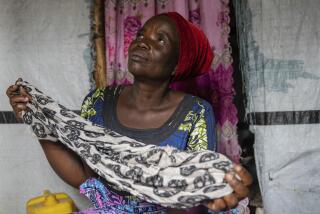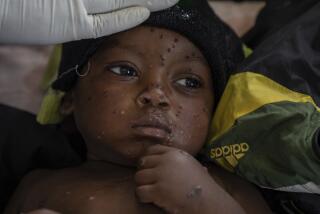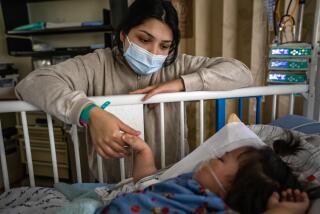Ebola outbreak instills terror in West African families
Reporting from Johannesburg, South Africa — Even the word was chilling: Ebola. The virus stole into the girl’s house in her small eastern Guinea town, invisible as death, and swiftly killed her grandmother and great-aunt. There were dark rumors everywhere that Ebola was witchcraft.
Soon her mother and aunt fell sick too. Health workers with Doctors Without Borders came and talked to the family for a long time. Then they donned yellow heavy plastic suits, white plastic aprons, masks and bibs and took 12-year-old Rose and her mother and aunt away in an ambulance.
And everybody knew that when they took you away, you never came back.
This is a time of terror in many West African communities as they face the world’s worst outbreak of one of the deadliest known diseases, easily spread through bodily fluids and difficult and dangerous to treat. Rose’s story, recounted by her nurse, exemplifies the fear — and sometimes bravery — that comes with the epidemic.
In the Doctors Without Borders isolation ward, things got worse for Rose’s family. Her mother, feeling depressed and hopeless, gave up, waiting for death. Her aunt was also sure she was going to die.
“No, you’re not,” Rose insisted.
But they had a right to be afraid. Only about 40% of those sickened in the outbreak have survived; in previous outbreaks, the mortality rate has been as high as 90%.
Since this outbreak began in Guinea in February, nearly 730 people have died there and in neighboring Liberia and Sierra Leone, the World Health Organization said Thursday. The risk for health workers is high and several senior doctors have died, including Sierra Leone’s top Ebola doctor, Sheik Umar Khan.
For some foreign health workers, the hardest thing isn’t wearing the suffocating plastic suits in the humid West African heat. Nor is it the impossible-to-answer questions from terrified people as they watch loved ones being taken away, perhaps forever.
It is the children in their cribs in the isolation units. Toys are placed in the beds with them, and the cribs are placed near windows, so people outside the unit can wave.
“The people inside the treatment center are completely alone. We can’t be there with them for hours on end. We have to go in and out,” said Monia Sayah, a Doctors Without Borders nurse who recently returned home to the United States after treating patients and counseling families for 11 weeks in Guinea. She worked on an Ebola outbreak in the Democratic Republic of Congo in 2012.
Sayah said she was especially moved by the children. There was Rose, the 12-year-old who refused to give up. There were babies whom she sadly watched die. She saw no child younger than 4 survive Ebola.
Doctors Without Borders encourages family members of patients, especially relatives of small children, to don protective garments and go into the isolation ward to be with them. But some are too afraid.
With the outbreak raging out of control, Sierra Leone’s president, Ernest Bai Koroma, declared a state of emergency late Wednesday, quarantined areas affected by the virus, banned public gatherings, and deployed security forces to assist in house-to-house searches to find those with symptoms, after dozens of suspected victims fled in panic.
The U.S. Centers for Disease Control and Prevention on Thursday warned Americans to avoid all non-essential travel to Guinea, Liberia and Sierra Leone.
Michael Stulman of Catholic Relief Services, currently in Sierra Leone, said the outbreak is likely to get worse before it improves.
“We definitely haven’t seen the worst of it. The treatment centers are at full capacity and as soon as a new treatment center is set up it’s almost immediately full,” he said.
“This is a scary virus and it can kill you, and the majority of people with it are dying. As soon as someone from the World Health Organization shows up and says your family member or friend has tested positive and we need to monitor you, people get scared and they hide.”
One of Sayah’s roles was to visit the homes of suspected victims and take people with her to treatment facilities. She encountered suspicion, mistrust and even hostility. Yet some people understand that the doctors are there to help.
One village family had lost seven members before Sayah met with them. When she arrived at their house, she donned protective gear and carefully entered. She saw a sick woman, about 40 years old.
“You look at them and you talk to them and you can see if they are not going to make it,” Sayah said. She recommended that the woman be taken for treatment, but she died the next day.
Some communities in Guinea blame humanitarian agencies and health workers for bringing the disease. Stulman said myths had spread that the hospitals were killing centers from which no one emerged alive, or that the disease didn’t really even exist, having been concocted by humanitarian agencies to raise money.
But there has been progress recently in public education, he said. “People are now acknowledging Ebola does exist. But this is going to need a lot more work.”
Catholic Relief Services is running education campaigns in the region to get the message out that those who seek treatment, which includes rehydration and medication for symptoms, have a better chance of survival.
When Rose’s mother and aunt were at their lowest points in the Doctors Without Borders isolation ward, the girl was at her most determinedly cheerful. She knew all the staff members and patients by name. She chirped and chattered.
“She was very brave, very mature,” Sayah said. “She was taking care of her mother, who was very sick. She was very strong and very dynamic.”
When her mother or aunt lost hope, she kept coaxing them. She told them to keep drinking water.
“They were very depressed and thought they were going to die,” Sayah said. But they recovered and eventually went home. Rose, still infectious, had to stay on in an isolation facility. So she appointed herself an unofficial medical assistant, hovering around helpfully, telling Sayah if she missed something.
Some survivors are shunned when they return to their villages. Many face a financial struggle, having lost their family breadwinners.
“The impact on these families, outside the emotion and trauma of their loss, is that the people who are most affected are usually young and strong because they’re the ones taking care of the sick all day,” Sayah said.
Doctors Without Borders meets with village elders and community members and counsels patients, often for hours, on the need to seek treatment. Family members also ask questions.
“A lot of them will say, ‘Are they coming back?’ It’s a very hard question to answer. It’s important to be honest. You just tell the truth and say you will do your best and get them as quickly as possible to the treatment facility,” Sayah said.
Rose was one of the lucky ones. She recovered and went home. But afterward, she frequently returned to the place where she had nearly died.
“She and her aunt came back every day to the facility to see us,” Sayah said. “They just needed to come back.”
More to Read
Sign up for Essential California
The most important California stories and recommendations in your inbox every morning.
You may occasionally receive promotional content from the Los Angeles Times.










